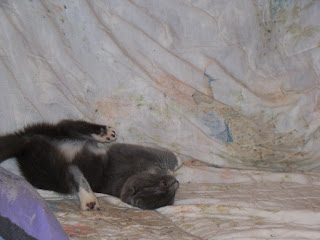
Here we are in the driveway. And ole' crowbait decided to let lose a big fart and scare himself so that he started crowhopping for a few seconds. I wasn't expecting that.
No matter when you start, it is important that you do not stop after starting. No matter when you end, it is more important that you do not regret after ended.

 I love to watch the kittens play and took this series of photos of them playing on the couch the other day. They have all kinds of toys but prefer to play with each other more than the toys. The gray kitten is about half the size of the black one but she can still hold her own when it comes to the wrestling matchs.
I love to watch the kittens play and took this series of photos of them playing on the couch the other day. They have all kinds of toys but prefer to play with each other more than the toys. The gray kitten is about half the size of the black one but she can still hold her own when it comes to the wrestling matchs.















 First cold lead of day
First cold lead of day This and the next two photos are of Wiley playing his favorite game of Catch the Feather. You can see a chicken feather floating down a little bit above his nose, looking like it is almost part of the plant.
This and the next two photos are of Wiley playing his favorite game of Catch the Feather. You can see a chicken feather floating down a little bit above his nose, looking like it is almost part of the plant.







 The western side of Mount Saint Helens as seen from the Visitor Center at Silver Lake, 46 road-miles away.
The western side of Mount Saint Helens as seen from the Visitor Center at Silver Lake, 46 road-miles away. From a viewpoint on the north-northwest side.
From a viewpoint on the north-northwest side. Clouds covered the upper half of the volcano for the entire afternoon with an occasional break, which briefly revealed the peaks. This, and the remaining photos were taken from the Johnston Ridge Observatory. Named for David A. Johnston, a volcanologist on duty nearby on that fateful day. His last words were “Vancouver, this is it!”
Clouds covered the upper half of the volcano for the entire afternoon with an occasional break, which briefly revealed the peaks. This, and the remaining photos were taken from the Johnston Ridge Observatory. Named for David A. Johnston, a volcanologist on duty nearby on that fateful day. His last words were “Vancouver, this is it!” The lateral blast exploded to the north toward what is now Johnston Ridge and, quite literally, destroyed everything in its path.
The lateral blast exploded to the north toward what is now Johnston Ridge and, quite literally, destroyed everything in its path. The mountains and valleys were tall old-growth forest. Now all that remains are a few denuded logs lying about like pick-up-sticks.
The mountains and valleys were tall old-growth forest. Now all that remains are a few denuded logs lying about like pick-up-sticks.
 A park service sign nearby tells a tale of the blast as “spoken” by this stump: “Step up and look at me carefully. Notice my shattered trunk, my missing top. I once stood 150 feet tall, surrounded by a beautiful forest of green and growing trees. When the blast exploded sideways out of the mountain, it plowed through the debris avalanche and swept across the landscape, picking up and carrying large chunks of rock, ice, and splintered wood.”
A park service sign nearby tells a tale of the blast as “spoken” by this stump: “Step up and look at me carefully. Notice my shattered trunk, my missing top. I once stood 150 feet tall, surrounded by a beautiful forest of green and growing trees. When the blast exploded sideways out of the mountain, it plowed through the debris avalanche and swept across the landscape, picking up and carrying large chunks of rock, ice, and splintered wood.” Down in the valley, the blast dumped 680 feet of debris, filling Spirit Lake to the east with logs and ash.
Down in the valley, the blast dumped 680 feet of debris, filling Spirit Lake to the east with logs and ash. Johnston Ridge was completely denuded. Spirit Lake lies beneath the far ridge at left-center and St. Helens rises up from the valley on the right.
Johnston Ridge was completely denuded. Spirit Lake lies beneath the far ridge at left-center and St. Helens rises up from the valley on the right. The early evening light emphasizes the ridges and the gulleys now being carved out by the flow of water.
The early evening light emphasizes the ridges and the gulleys now being carved out by the flow of water. Another view of cloud shrouded St. Helens from Johnston Ridge in the early evening. All photos were taken on Sunday, September 12th.
Another view of cloud shrouded St. Helens from Johnston Ridge in the early evening. All photos were taken on Sunday, September 12th.